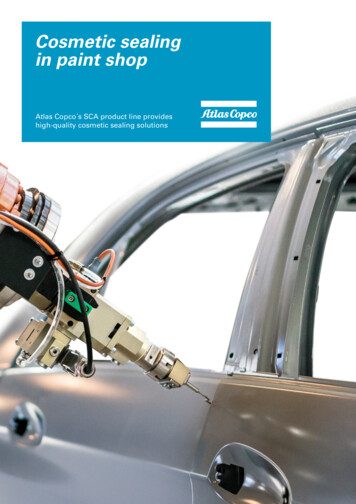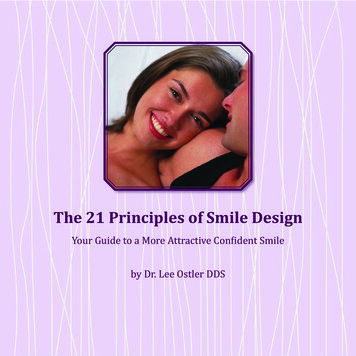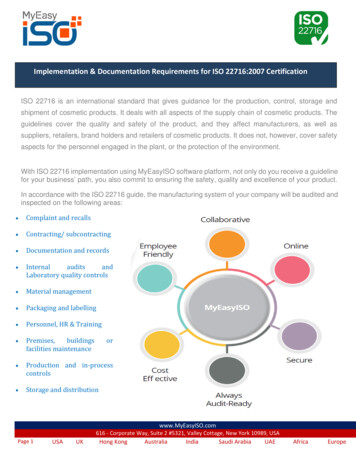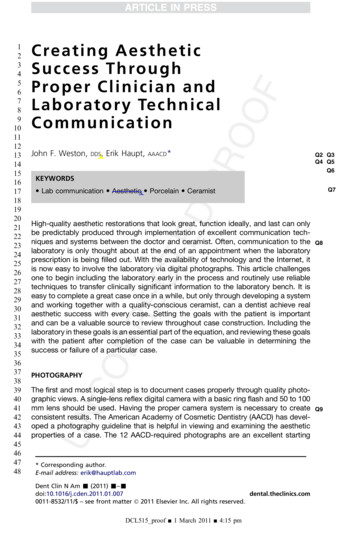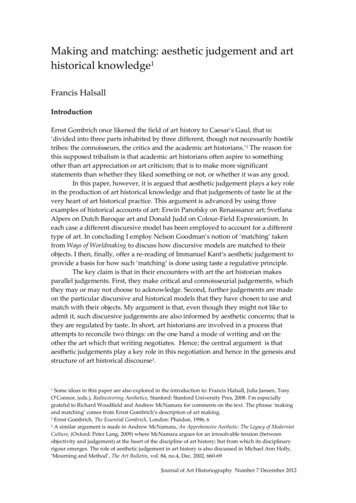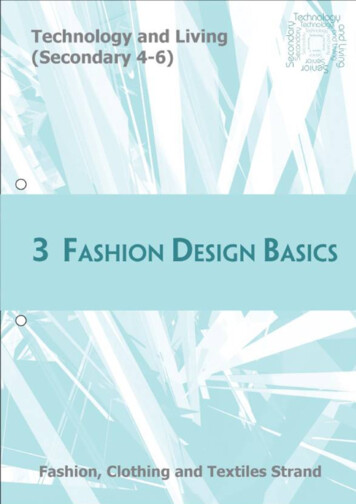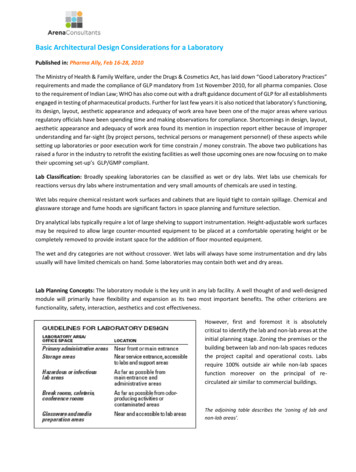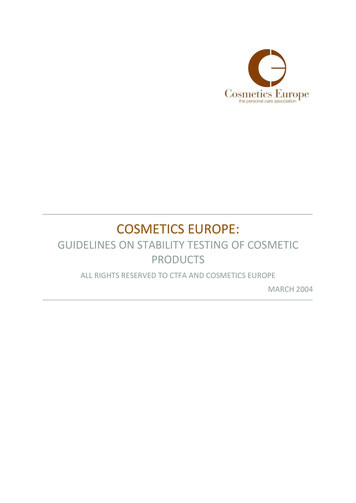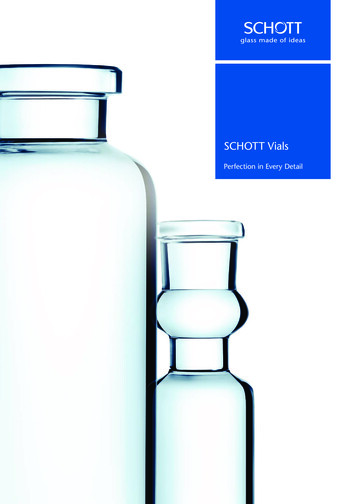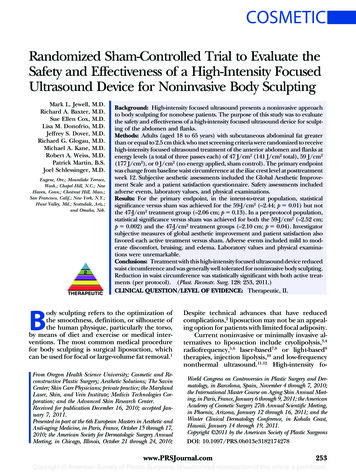
Transcription
COSMETICRandomized Sham-Controlled Trial to Evaluate theSafety and Effectiveness of a High-Intensity FocusedUltrasound Device for Noninvasive Body SculptingMark L. Jewell, M.D.Richard A. Baxter, M.D.Sue Ellen Cox, M.D.Lisa M. Donofrio, M.D.Jeffrey S. Dover, M.D.Richard G. Glogau, M.D.Michael A. Kane, M.D.Robert A. Weiss, M.D.Patrick Martin, B.S.Joel Schlessinger, M.D.Eugene, Ore.; Mountlake Terrace,Wash.; Chapel Hill, N.C.; NewHaven, Conn.; Chestnut Hill, Mass.;San Francisco, Calif.; New York, N.Y.;Hunt Valley, Md.; Scottsdale, Ariz.;and Omaha, Neb.Background: High-intensity focused ultrasound presents a noninvasive approachto body sculpting for nonobese patients. The purpose of this study was to evaluatethe safety and effectiveness of a high-intensity focused ultrasound device for sculpting of the abdomen and flanks.Methods: Adults (aged 18 to 65 years) with subcutaneous abdominal fat greaterthan or equal to 2.5 cm thick who met screening criteria were randomized to receivehigh-intensity focused ultrasound treatment of the anterior abdomen and flanks atenergy levels (a total of three passes each) of 47 J/cm2 (141 J/cm2 total), 59 J/cm2(177 J/cm2), or 0 J/cm2 (no energy applied, sham control). The primary endpointwas change from baseline waist circumference at the iliac crest level at posttreatmentweek 12. Subjective aesthetic assessments included the Global Aesthetic Improvement Scale and a patient satisfaction questionnaire. Safety assessments includedadverse events, laboratory values, and physical examinations.Results: For the primary endpoint, in the intent-to-treat population, statisticalsignificance versus sham was achieved for the 59-J/cm2 (–2.44; p 0.01) but notthe 47-J/cm2 treatment group (–2.06 cm; p 0.13). In a per-protocol population,statistical significance versus sham was achieved for both the 59-J/cm2 (–2.52 cm;p 0.002) and the 47-J/cm2 treatment groups (–2.10 cm; p 0.04). Investigatorsubjective measures of global aesthetic improvement and patient satisfaction alsofavored each active treatment versus sham. Adverse events included mild to moderate discomfort, bruising, and edema. Laboratory values and physical examinations were unremarkable.Conclusions: Treatment with this high-intensity focused ultrasound device reducedwaist circumference and was generally well tolerated for noninvasive body sculpting.Reduction in waist circumference was statistically significant with both active treatments (per protocol). (Plast. Reconstr. Surg. 128: 253, 2011.)CLINICAL QUESTION/LEVEL OF EVIDENCE: Therapeutic, II.Body sculpting refers to the optimization ofthe smoothness, definition, or silhouette ofthe human physique, particularly the torso,by means of diet and exercise or medical interventions. The most common medical procedurefor body sculpting is surgical liposuction, whichcan be used for focal or large-volume fat removal.1From Oregon Health Science University; Cosmetic and Reconstructive Plastic Surgery; Aesthetic Solutions; The SavinCenter; Skin Care Physicians; private practice; the MarylandLaser, Skin, and Vein Institute; Medicis Technologies Corporation; and the Advanced Skin Research Center.Received for publication December 16, 2010; accepted January 7, 2011.Presented in part at the 6th European Masters in Aesthetic andAnti-aging Medicine, in Paris, France, October 15 through 17,2010; the American Society for Dermatologic Surgery AnnualMeeting, in Chicago, Illinois, October 21 through 24, 2010;Despite technical advances that have reducedcomplications,2 liposuction may not be an appealing option for patients with limited focal adiposity.Current noninvasive or minimally invasive alternatives to liposuction include cryolipolysis,3,4radiofrequency,5,6 laser-based7,8 or light-based9therapies, injection lipolysis,10 and low-frequencynonthermal ultrasound.11,12 High-intensity foWorld Congress on Controversies in Plastic Surgery and Dermatology, in Barcelona, Spain, November 4 through 7, 2010;the International Master Course on Aging Skin Annual Meeting, in Paris, France, January 6 through 9, 2011; the AmericanAcademy of Cosmetic Surgery 27th Annual Scientific Meeting,in Phoenix, Arizona, January 12 through 16, 2011; and theWinter Clinical Dermatology Conference, in Kohala Coast,Hawaii, January 14 through 19, 2011.Copyright 2011 by the American Society of Plastic SurgeonsDOI: 10.1097/PRS.0b013e3182174278www.PRSJournal.com253
Plastic and Reconstructive Surgery July 2011Disclosures: Financial support was provided byMedicis Technologies Corporation, Scottsdale, Ariz.Dr. Jewell has served as a consultant for Allergan,AorTech, Medicis, and Sound Surgical. He hasreceived grants for clinical research from Allergan,Medicis, and Mentor and has received grants foreducational activities from Medicis. Dr. Baxter hasserved as a consultant to Allergan, Lifecell, andMedicis. Dr. Cox has received grants for clinicalresearch from Allergan and Medicis; has served as aprincipal investigator for Allergan, Medicis, andRevance; has served as a consultant to Allergan,Medicis, Johnson & Johnson, and Merz; and hasserved as an advisor for Allergan and Medicis. Dr.Donofrio has received grant/research support fromAllergan, Cynosure, Medicis, Mentor, and Merz;has served as a consultant for Medicis, Niadyne,and Vichy; has been on speakers bureaus for Mentorand Vichy; and has served on an advisory board forMedicis. Dr. Dover has served as an advisor orconsultant for Iridex Corporation, Zeltiq, Lumenis,Medicis, Shaser, and Solta Medical; has receivedgrants for clinical research from Allergan, Cynosure,Lumenis, Medicis, Merz Pharma, OpusMed, Palomar, Shaser, Syneron, and Solta Medical; and ownsstock, stock options, or bonds from CVS/Skin Effectsand Shaser. Dr. Glogau has served as an advisor orconsultant for Allergan, Medicis, Revance, Liposonix, and Lumenis; has received grants for clinicalresearch from Allergan, Medicis, Revance, and Liposonix; and does not own stock, stock options, orbonds from any of the companies. Dr. Kane hasserved as an advisor or consultant for Allergan,BioForm Medical, Medicis, QMed, and Stiefel Laboratories; has served as a speaker or a member of aspeaker’s bureau for Allergan, Medicis, QMed, andSanofi-Aventis; has received grants for clinical research from Coapt Systems, Medicis, and RevanceTherapeutics; and owns stock, stock options, orbonds from Allergan, Medicis, and Revance. Dr.Weiss has received grant/research support fromMedicis, Palomar, Ultrashape, and Zeltiq; hasserved as a consultant for Cooltouch and Medicis;has been on speakers bureaus for Allergan, Colbar,Cooltouch, Johnson & Johnson, and Palomar; andis a stockholder in Cooltouch. Patrick Martin is anemployee of Medicis Technologies Corporation. Dr.Schlessinger has served on an advisory board or as aconsultant to Abbott Pharma, Allergan, Amgen,Artes, Dermik, Galderma, Genentech, GSK/Stiefel,Kythera, Medicis, Mentor, Merz, Novartis, Obagi,and Ortho Pharma (Johnson & Johnson); hasserved as a researcher for 3M Pharma, Abbott254cused ultrasound generates high-energy ultrasonic waves (100 to 10,000 W/cm2) that convergeat a specific focal point in subcutaneous tissue13where temperatures are rapidly raised to greaterthan 65 C, the temperature at which cell necrosisoccurs in adipocytes.14 The technique allows localized destruction of adipose tissue at precise tissue depths without damage to the surroundingtissue or skin surface.13The efficacy and safety of high-intensity focused ultrasound are suggested by two large caseseries presenting results for 387 patients who received treatments for the reduction of waistcircumference.15,16 However, data from sham-controlled, randomized trials are lacking. The currentrandomized controlled trial sought to evaluate thesafety, tolerability, and effectiveness of a high-intensity focused ultrasound device (LipoSonix system; Medicis Technologies Corp., Scottsdale,Ariz.) for body sculpting.PATIENTS AND METHODSDesignThis was a multicenter, randomized, sham-controlled, single-blind trial evaluating the effectivenessand safety of a high-intensity focused ultrasound devicefor waist circumference reduction. The study receivedinstitutional review board approval and was conductedin accordance with the Declaration of Helsinki. Allpatients provided written informed consent. Trialregistration (ClinicalTrials.gov NCT00906815) occurred on May 19, 2009; the first patient was enrolledon June 17, 2009.PatientsMen and women aged 18 to 65 years with abody mass index less than or equal to 30 kg/m2and a thickness of subcutaneous adipose tissue inthe abdomen and flanks greater than or equal to2.5 cm were eligible. Thickness of subcutaneousPharma, Allergan, Amgen, Astellas, Barrier Therapeutics, Biogen, Centocor, Clay-Park Labs, Collagenix, Connetics, Dermik, Dow, Lumenis, Galderma,Genentech, GSK/Stiefel, Glenmark Pharma,HealthPoint, Immunex, Kythera, Medicis, Mentor,Merz, Novartis, Novum, Nucryst, Ortho Pharma(Johnson & Johnson), Penederm Pharma, Perrigo,Pfizer, QLT USA, Regeneratio Pharma AG, Sandoz, Schering-Plough, Stiefel Labs, and UBC/Vitae;and is a stockholder in Allergan, Revance, ExcelCosmeceuticals, Medicis, and Obagi.
Volume 128, Number 1 High-Intensity Focused Ultrasoundadipose was first assessed by a manual pinch test.If thickness was greater than or equal to 2.5 cm,the assessment was repeated using standard calibrated, spring-loaded skin fold calipers, and, ifalso greater than or equal to 2.5 cm, confirmedusing diagnostic ultrasound (M-Turbo with L-38 7to 5-MHz linear array probe; SonoSite, Inc., Bothell, Wash.).Exclusion criteria included coagulation disorders or use of medications/dietary supplementsthat limit coagulation or platelet aggregation; diabetes or cardiovascular disease; any prior aesthetic procedure, surgical scar, or laparoscopicsurgery in the treatment area; skin disease, abnormalities of the skin or soft tissues of the abdominalwall, sensory loss, dysesthesia, or metal implants inthe treatment area; weight-loss medication or programs; weight-reduction surgical procedures; skinor superficial tissue that did not independently lieflat when the patient was supine; current use ofchronic steroid or immunosuppressive therapy;implantable electrical device; history of cancer;illicit drug use or alcohol abuse (i.e., four or moredrinks per day); and problems adhering to thestudy schedule. Pregnant and lactating womenwere also excluded.Patients agreed to not change their diet orexercise routine; participate in any weight-lossprogram; use any substance for promoting weightloss; or undergo any cosmetic procedure (including surgery) of the trunk, torso, or abdomen. Adherence to these guidelines was reemphasized andmonitored by means of queries at each visit.TreatmentStudy participants were assigned randomly1:1:1 to receive high-intensity focused ultrasoundat total doses of 177 J/cm2 (three passes at 59J/cm2), 141 J/cm2 (three passes at 47 J/cm2), or0 J/cm2 (three passes; sham group) to the treatment area defined by the investigator. This areawas marked with a grid of 2.8 2.8-cm sites to betreated with each pass of the transducer and waslimited to the anterior abdomen and flanks; investigators were advised to treat only areas accessible with the patient in the supine position. Analgesia during and after the procedure wasadministered entirely at the discretion of the treating investigator.Study EndpointsThe primary efficacy endpoint was changefrom baseline waist circumference at 12 weeks,determined as the average of two measurementstaken at the height of the iliac crest. Waist circumference was measured with a standardized calibrated tape measure using a standardized andvalidated technique that considered patient positioning, posture, height, dress, and breathing.17Secondary endpoints included change frombaseline waist circumference at 4 and 8 weeks. Atweek 12, patients completed a patient satisfactionsurvey rating their perceived improvement withthe flatness of their abdomen (i.e., 1, much worse;2, worse; 3, no improvement; 4, improved; and 5,much improved), likeliness to pursue additionaltreatments (i.e., 1, very unlikely; 2, unlikely; 3,neutral; 4, likely; and 5, very likely), and generalsatisfaction with results (i.e., 1, very dissatisfied; 2,mildly dissatisfied; 3, neutral; 4, satisfied; and 5,very satisfied). Overall satisfaction was calculatedas the mean of the three item scores, with a meanscore greater than 3.0 defined as “satisfied.”On the first 7 days following treatment, patients rated discomfort using a 100-mm visual analogue scale (i.e., 0 to 4, no pain; 5 to 44, mild pain;45 to 74, moderate pain; and 75 to 100, severepain). Concomitant medications were recorded atbaseline and at each visit.Investigators rated global aesthetic improvement at weeks 4, 8, and 12 using the Global Aesthetic Improvement Scale (i.e., 0, much worse; 1,worse; 2, no change; 3, improved; and 4, muchimproved). Ratings were based on review of standardized digital photographs of the anterior abdomen (straight-on view) and the right and leftflanks (lateral views). Photographic technique wasconsistent with American Society of Plastic Surgeons standards.Safety endpoints included adverse events, serious adverse events, and unanticipated adversedevice events, which were recorded at all follow-upvisits. A serious adverse event was defined as anyevent that was life-threatening, resulted in permanent damage or impairment of a body function orstructure, or required medical or surgical intervention to avoid such outcomes. Unanticipatedadverse device events were defined as any seriouseffect on health or safety or any life-threateningproblem or death caused by or associated with thedevice, if not previously identified in the investigational plan, or any other unanticipated seriousproblem associated with the device that relates tothe patient’s rights, safety, or welfare.Blood samples for clinical chemistry were obtained before treatment; 1 hour after treatment;and at weeks 1, 4, 8, and 12. The samples wereanalyzed for lipid profiles; markers of inflammation, coagulation, and liver or renal function; he-255
Plastic and Reconstructive Surgery July 2011matologic assessments; and blood chemistry. Fullphysical examinations were performed at baselineand at week 12; the treatment area was examinedat each visit.Statistical MethodsEffectiveness and safety were assessed in theintent-to-treat population, which included alltreated patients. Effectiveness was also assessed ina per-protocol population, which included onlypatients who did not have major protocol violations, completed treatment as planned, and didnot develop any new conditions or experienceexacerbations of existing conditions that mightconfound analysis of the primary endpoint.Least squares mean changes from baselinewaist circumference were evaluated using analysisof covariance, with treatment and study site asfixed effects and baseline waist circumference andweight change from baseline as covariates. Theleast squares mean (the group mean, corrected forimbalances in other variables by holding them atthe mean value) was used to attempt to correct forweight change. For missing waist circumferencemeasurements at week 12, the last nonmissing observation was carried forward.Overall patient satisfaction was assessed usinganalysis of covariance. Missing values were replaced with the mean value of patients from thesame treatment group with nonmissing data.Group differences in the proportion of patientsreporting overall satisfaction and having investigator-rated aesthetic improvements (Global Aesthetic Improvement Scale score ⱖ3) were evaluated using the Cochran-Mantel-Haenszel test.Patient discomfort (visual analogue scale diary)and adverse events were summarized using descriptive statistics.RESULTSPatients and Treatment ComplianceOne hundred eighty patients were randomized at nine sites between June 17, 2009, and January 6, 2010, to receive total high-intensity focusedultrasound doses of 141 J/cm2 [three passes at47 J/cm2; n 63 (35.0 percent)] or 177 J/cm2[three passes at 59 J/cm2; n 59 (32.8 percent)]or sham treatment [n 58 (32.2 percent)]. Patients were predominantly women (85 percent)and white (87 percent), with a mean age of42.1 years and a mean body mass index of 25.2kg/m2 (Table 1).All 180 patients were included in the intentto-treat and safety populations. Four patients(2.2 percent) did not complete the 12-week follow-up visit. The per-protocol population (n 168) excluded 12 patients for failure to complete treatment (discomfort, n 6; device malfunction, n 1), exclusion criteria (n 3), orthe worsening of a preexisting medical condition (Graves disease, n 1; irritable bowel syndrome, n 1) (Fig. 1).The mean number of 2.8 2.8-cm sites onthe abdomen and flanks treated with each energy pass was 30.8 (sham), 35.1 (47 J/cm2), and31.6 (59 J/cm2). The mean area treated was241.5 cm2 (range, 117.6 to 470.4 cm2) in thesham group, 275.2 cm2 (range, 133.3 to 611.5cm2) in the 47-J/cm2 group, and 247.7 cm2(range, 54.9 to 533.0 cm2) in the 59-J/cm2 group;mean exposure time was 41.6, 47.4, and 42.7 minutes, respectively. Body weight remained stable(mean change, ⱕ0.55 kg per group) throughoutthe study, suggesting good compliance with dietand exercise requirements (Table 2).Table 1. Patient Demographic CharacteristicsTreatment Group*CharacteristicNo. of patientsAge (mean SD), yrWomen, n (%)Race, n (%)WhiteNonwhiteHeight (mean SD), cmWeight (mean SD), kgBMI (mean SD), kg/m2Sham47 J/cm259 J/cm2Total5841.1 10.747 (81.0)5942.2 10.852 (88.1)6342.8 11.254 (85.7)18042.1 10.9153 (85.0)51 (89.9)7 (12.1)167.7 9.669.8 13.324.6 2.652 (88.1)7 (11.9)166.1 9.370.4 11.225.4 2.653 (84.1)10 (15.9)165.2 8.169.6 10.625.4 2.7156 (86.7)24 (13.3)166.3 9.069.9 11.625.2 2.6BMI, body mass index.*Treatment consisted of three passes at the specified energy level.256
Volume 128, Number 1 High-Intensity Focused Ultrasoundpasses) had a statistically significantly greater leastsquares mean change from baseline waist circumference at 12 weeks compared with sham-treatedpatients (–2.44 versus –1.43 cm; p 0.014) (Fig.2). In the per-protocol population, there was astatistically significantly greater least squares meanchange from baseline waist circumference at week12 versus sham in both the 47-J/cm2 (–2.10 versus–1.21 cm; p 0.04) and 59-J/cm2 (–2.52 versus–1.21 cm; p 0.002) groups. The extent of response varied between groups (Table 3). Baselineand week-12 photographs of one patient from eachactive treatment group are shown in Figure 3.Fig. 1. Patient disposition.Table 2. Mean Weight Change from BaselineTreatmentGroup*Sham47 J/cm259 J/cm2Week1 (kg)Week4 (kg)Week8 (kg)Week12 0.550.01*Treatment consisted of three passes at the specified energy level.Primary Effectiveness EndpointsIn the intent-to-treat population, patientstreated at the energy level of 59 J/cm2 (threeSecondary Effectiveness EndpointsIn the intent-to-treat population, a significantly greater least squares mean change frombaseline waist circumference was observed at4 and 8 weeks in patients treated with 59 J/cm2compared with the sham group (Fig. 4). In the47-J/cm2 group, there was a significant differenceonly at week 8. In the per-protocol population,both active treatments were significantly superiorto sham at 4 and 8 weeks.At week 12, patient overall satisfaction washigher in the active treatment groups versus thesham group, but the difference was significantonly in the 59-J/cm2 group (Table 4). Significantlymore patients receiving either active treatmentversus sham rated the flatness of their stomach as“improved” or “much improved,” and no patientreceiving active treatment reported a worsening. Asimilar proportion of patients receiving activetreatment at either energy level were “likely” orFig. 2. Least squares mean change from baseline in waist circumference at 12 weeks (lastobservation carried forward) in the intent-to-treat and per-protocol populations. ITT, intent to treat; PP, per-protocol. *p 0.014 versus sham. †p 0.035 versus sham and ‡p 0.002 versus sham, both significant at the 0.05 level according to the Hochberg procedure. Treatment consisted of three passes at the specified energy level.257
Plastic and Reconstructive Surgery July 2011Table 3. Summary of Change from Baseline WaistCircumference at Week 12Treatment Group*47 J/cm2No. of patientsResponseAny reductionin waistcircumferenceNo. (%)Meanⱖ1-cm reductionNo. (%)Meanⱖ2-cm reductionNo. (%)Meanⱖ3-cm reductionNo. (%)Mean5859 J/cm260CombinedActiveTreatment11845 (77.6) 2.6150 (83.3) 3.2695 (80.5) 2.9537 (63.8) 3.0345 (75.0) 3.5782 (69.5) 3.3325 (43.1) 3.7832 (53.3) 4.4657 (48.3) 4.1615 (25.9) 4.6420 (33.3) 5.6835 (29.7) 5.23*Treatment consisted of three passes at the specified energy level.“very likely” to pursue additional treatment if itwere required (range, 51.7 to 53.4 percent). Therewas a nonsignificant trend for more patients withactive treatment (47.5 percent) to be “satisfied” or“very satisfied” with treatment results comparedwith sham (36.2 percent).The majority of patients receiving active treatment judged the results as “improved” or “muchimproved” at weeks 4, 8, and 12 (Global AestheticImprovement Scale) (Fig. 5 and Table 5). Differences between both active treatment groups and thesham group were statistically significant at all timepoints.Posttreatment discomfort (assessed using a100-mm visual analogue scale) on the day of treatment was greater with active treatment (47 J/cm2,23.5 mm; 59 J/cm2, 32.5 mm) versus sham (3.0mm). At all time points, mean scores were higherwith active treatment (range across all time pointsand active treatments, 2.4 to 32.5 mm; no pain tomild pain) compared with sham (ⱕ4 mm; nopain) but, by day 5, had decreased to the level ofno pain (3.9 mm) in the 47-J/cm2 group and almost to the level of no pain (7.4 mm) in the59-J/cm2 group (Fig. 6). Analgesic products (primarily acetaminophen, ibuprofen, and naproxen)were administered to 40 patients (22.2 percent)before, during, or after the procedure. Use wasgreater before (sham, 10.3 percent; 47 J/cm2,20.3 percent; 59 J/cm2, 28.6 percent) versus during (sham, 5.2 percent; 47 J/cm2, 13.6 percent;59 J/cm2, 20.6 percent) or after (sham, 6.9 percent; 47 J/cm2, 11.9 percent; 59 J/cm2, 22.2percent) treatment.258SafetyThe most common treatment-emergent adverse events were pain, bruising, and edema (Table 6). Severe procedural pain was reported inthree patients (5.1 percent) in the 47-J/cm2 groupand in six patients (9.5 percent) in the 59-J/cm2group. All other patients reported mild or moderate pain during the procedure. No patient experienced severe postprocedural pain. All painresolved within 7 to 10 days. Bruising and edemaresolved within 12 to 14 days and 13 to 16 days,respectively, and were almost exclusively mild tomoderate in intensity. The single exception was apatient in the 59-J/cm2 group who experiencedsevere bruising.There were no unanticipated adverse events orunanticipated adverse device events. Two seriousadverse events (i.e., pneumonia and breast cancer) were reported, but neither was considered bythe investigator to be related to treatment.Clinical laboratory tests did not reveal any abnormalities with regard to lipid profiles, markersof inflammation, coagulation, liver or renal function, hematologic assessments, or blood chemistry. There were no notable findings from the physical examinations. There were no findings of skinburns, skin laxity, indurations, dimpling, or otheradverse skin effects besides the expected bruising.DISCUSSIONIn this randomized, controlled, multicenter,single-blind, sham-controlled study, noninvasiveablation of subcutaneous adipose tissue usinghigh-intensity focused ultrasound at total dosesof 141 J/cm2 (three passes at 47 J/cm2) and177 J/cm2 (three passes at 59 J/cm2) reducedwaist circumference from baseline and improvedsubjective measures of aesthetic appearance compared with sham treatment and was generally welltolerated. There was only a small difference intime required to perform the treatment with59 J/cm2 (mean duration, 42.7 minutes) versus47 J/cm2 (47.4 minutes), which may have beenattributable to the slightly larger (mean) treatedsurface area in the 47-J/cm2 group.In the intent-to-treat population, treatmentwith three passes at 59 J/cm2 was associated witha significantly greater reduction in waist circumference from baseline versus sham beginning atweek 4 and continuing through week 12 (primaryendpoint). There was a nonsignificant trend toward greater reduction at week 12 in the 47-J/cm2group versus sham, with significant separation between active treatment and sham only at week 8.
Volume 128, Number 1 High-Intensity Focused UltrasoundFig. 3. Patient photographs at baseline (first and third columns) and posttreatment week 12 (second and fourth columns). (Above)Patient from the 47-J/cm2 group with change from baseline waist circumference of –2.45 cm at posttreatment week 12. (Below)Patient from the 59-J/cm2 group with change from baseline waist circumference –2.55 cm at posttreatment week 12.Fig. 4. Least squares mean change from baseline waist circumference at 4 and 8 weeks(last observation carried forward) in the intent-to-treat and per-protocol populations. ITT,intent to treat; PP, per protocol. *p 0.001 versus sham; †p 0.037 versus sham; ‡p 0.005 versus sham. Treatment consisted of three passes at the specified energy level.In the per-protocol population, significantlygreater reductions from baseline waist circumference were observed with either active treatmentversus sham beginning at week 4. A greaterthan or equal to 3-cm reduction was observed in26 percent of the 47-J/cm2 group (mean, – 4.64cm) and 33 percent of the 59-J/cm2 group (mean,–5.68 cm).In the intent-to-treat population, the lack ofa statistically significant treatment effect in the47-J/cm2 group versus sham at week 12 was likelybecause three of these patients received one orfewer of three passes (ⱕ33.3 percent of total energy dose) because of discomfort or device malfunction and were included in the intent-to-treatanalysis. The results for the per-protocol popula-259
Plastic and Reconstructive Surgery July 2011Table 4. Results from the Patient Satisfaction Survey at Week 12Treatment Group*Patient ResponseSham, No. (%)(n ⴝ 58)47 J/cm2,No. (%)(n ⴝ 58)59 J/cm2,No. (%)(n ⴝ 60)Combined ActiveTreatment, No. (%)(n ⴝ 118)2 (3.4)12 (20.7)43 (74.1)1 (1.7)0—5 (8.6)27 (46.6)26 (44.8)000.0044 (6.7)37 (61.7)19 (31.7)00 0.0019 (7.6)64 (54.2)45 (38.1)00 0.00120 (34.5)11 (19.0)14 (24.1)10 (17.2)3 (5.2)—16 (27.6)15 (25.9)12 (20.7)10 (17.2)5 (8.6)0.82413 (21.7)18 (30.0)13 (21.7)9 (15.0)7 (11.7)0.38629 (24.6)33 (28.0)25 (21.2)19 (16.1)12 (10.2)0.4814 (6.9)17 (29.3)16 (27.6)11 (19.0)10 (17.2)—28 (48.3)—7 (12.1)19 (32.8)18 (31.0)9 (15.5)5 (8.6)0.45834 (57.6)0.3239 (15.0)21 (35.0)16 (26.7)8 (13.3)6 (10.0)0.31342 (66.7)0.02816 (13.6)40 (33.9)34 (28.8)17 (14.4)11 (9.3)0.29476 (62.3)0.070Question 1. “Please rate how much the flatness ofyour abdomen improved after treatment withthe LipoSonix system.”5 (much improved)4 (improved)3 (no improvement)2 (worse)1 (much worse)p vs. shamQuestion 2. “Assume that to achieve the best effectsyou would need to have a repeat treatment withthe LipoSonix system. Please rate how likely youwould be to come back for an additionaltreatment.”5 (very likely)4 (likely)3 (neutral)2 (unlikely)1 (very unlikely)p vs. shamQuestion 3. “Please rate how satisfied you are withthe results of your treatment.”5 (very satisfied)4 (satisfied)3 (neutral)2 (mildly dissatisfied)1 (very dissatisfied)p vs. shamOverall satisfaction, mean score 3p vs. sham*Treatment consisted of three passes at the specified energy level.Fig. 5. Global Aesthetic Improvement Scale (GAIS) scores at weeks 4, 8, and 12. *p 0.001versus sham. Treatment consisted of three passes at the specified energy level.tion may be more clinically relevant than thosefor the intent-to-treat population because theper-protocol results omit outcomes for partiallytreated patients.260Results from this study are consistent withthose of a Canadian trial in which three differentenergy levels (total energy doses of 141, 156, or177 J/cm2) directed at multiple tissue depths
Volume 128, Number 1 High-Intensity Focused UltrasoundTable 5. Improvement in Global Aesthetic Improvement Scale Scores at Weeks 4, 8, and 12*Treatment†Sham47 J/cm259 J/cm2All activeWeek 4, n/N (%)Week 8, n/N (%)Week 12, n/N (%)8/58 (13.7)33/59 (55.9)‡37/62 (59.7)‡70/121 (57.9)‡11/58 (19.0)38/58 (65.5)‡41/61 (67.2)‡79/119 (66.4)‡9/58 (15.5)42/58 (72.4)‡47/60 (78.3)‡89/118 (75.5)‡*The percentage of patients rated by investigators as “much improved” or “improved.”†Treatment consisted of three passes at the specified energy level.‡p 0.001 versus sham.Fig. 6. Changes in visual analogue scale (VAS) score during week 1 (0 to 4, no pain; 5 to44, mild pain; 45 to 74, moderate pain; and 75 to 100, severe pain). Treatment consistedof three passes at the specified energy level.Table 6. Common Treatment-Emergent Adverse Events*Adverse EventsPain during the procedurePostprocedure painBruising/ecchymosisEdema/swellingSham(n ⴝ 58)47 J/cm2(n ⴝ 59)59 J/cm2(n ⴝ 63)Combined ActiveTreatment (n ⴝ 122)780050363956033426110698111*Treatment consisted of three passes at the specified energy level.achieved similar reductions of waist circumference from baseline 12 weeks following treatmentof the anterior abdomen.18 Patients in our studyreported a high degree of compliance with dietand exercise restrictions (97.8 percent completedthe 12-week follow-up visit). The stability of bodyweight suggests that the effects of high-intensityfocused ultrasound are independent of changes todiet and exercise.Nonetheless, the small changes from baselinewaist circumference in the sham group suggestmodest effects i
ody sculpting refers to the optimization of the smoothness, definition, or silhouette of the human physique, particularly the torso, by means of diet and exercise or medical inter-ventions. The most common medical procedure for body sculpting is surgical lipos
